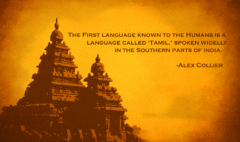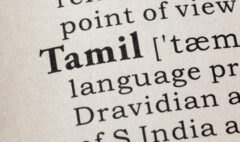The Role of Tamil in Tamil Nadu’s Culinary Heritage
The Role of Tamil in Tamil Nadu’s Culinary Heritage
The Role of Tamil in Tamil Nadu’s Culinary Heritage: The Language of a Great Cuisine
The culinary heritage of a region is one of its most important and most delicious cultural treasures. It is a story that is told through flavors, aromas, and time-honored techniques. The cuisine of Tamil Nadu is a particularly rich and ancient one, a sophisticated culinary tradition that has been shaped by thousands of years of history, geography, and culture. At the very heart of this tradition is the Tamil language. The language is the vessel that has carried the knowledge of this cuisine through the generations. It is the language of the ancient poems that describe the feasts of kings, the language of the handwritten traditional recipes passed down from grandmothers to their grandchildren, and the language that gives a name to the incredible variety of cultural foods in Tamil Nadu.
To truly understand the depth and the nuance of this cuisine, one must also understand the language that describes it. The process of learning Tamil with food is one of the most immersive, engaging, and deeply satisfying of all language-learning journeys. This exploration of the Tamil culinary history will reveal the profound and inseparable connection between the food on the plate and the words that are used to create and to celebrate it.
The Language of the Land: A Vocabulary Rooted in Agriculture
The foundation of any cuisine is its ingredients, and the Tamil vocabulary for food is deeply rooted in the agricultural landscape of the region. The language has beautifully specific words for the bounty of the land.
- The Primacy of Rice (அரிசி – Arisi): Rice is the staple grain, and the language reflects its central importance. There are different words for rice at its different stages: நெல் (nel) is the unhusked paddy in the field, அரிசி (arisi) is the uncooked, husked rice, and சாதம் (sātham) is the final, cooked rice that is served on the plate.
– The World of Lentils (பருப்பு – Paruppu): Lentils are the primary source of protein, and the language has specific names for all the key varieties, such as துவரம் பருப்பு (thuvaram paruppu) (toor dal) and பாசிப் பருப்பு (pāsip paruppu) (moong dal), which are the building blocks of dishes like sambhar and kootu.
– The Names of Native Vegetables: The language has a rich vocabulary for the native vegetables that have been cultivated in the region for centuries, such as கத்திரிக்காய் (kattirikkāy) (brinjal/eggplant), வெண்டைக்காய் (veṇṭaikkāy) (okra), and முருங்கைக்காய் (muruṅkaikkāy) (drumstick).
The “Aru Suvai”: A Culinary Philosophy Encoded in Language
As we’ve explored in other posts, the very philosophy of Tamil cuisine is encoded in a linguistic concept: the “Aru Suvai” (அறுசுவை), or the “six tastes.” This ancient concept, which states that a balanced meal should contain the six tastes of sweet (இனிப்பு), sour (புளிப்பு), salty (உவர்ப்பு), bitter (கசப்பு), pungent (கார்ப்பு), and astringent (துவர்ப்பு), is a guiding principle for all traditional cooking. The fact that the language has a specific and commonly understood word for the “astringent” taste—a concept that is often overlooked in Western cuisine—shows how deeply this philosophy is ingrained in the culture.
The Language of the Recipe: Cooking Verbs and Techniques
The Tamil language has a rich and precise vocabulary for the various cooking techniques that are used in the kitchen. Learning these words is a key part of learning Tamil with food.
- தாளிப்பு (Thāḷippu) – Tempering: This is perhaps the most important of all Tamil cooking techniques. It is the process of frying spices like mustard seeds, cumin seeds, and curry leaves in hot oil or ghee to release their aromatic oils. This “thaalippu” is then poured over the final dish. The language has a specific and universal word for this crucial first step.
– வறுப்பது (Vaṟuppatu) – Frying / Roasting: This refers to the process of dry-roasting spices to intensify their flavor before they are ground into a masala powder.
– அரைப்பது (Araippatu) – Grinding: This refers to the process of grinding soaked lentils and rice to make a batter, or of grinding coconut and spices to make a fresh masala paste.
– வேகவைப்பது (Vēkavaippatu) – Boiling / Cooking: The general term for cooking or boiling.
– குழம்பு (Kuḻampu): This is a key word in the culinary vocabulary. It refers to a specific category of tamarind-based stews or curries that are a cornerstone of the cuisine.
The Stories in the Names: Dishes with a History
The names of many cultural foods in Tamil Nadu often tell a story or describe the dish’s appearance or ingredients.
- கொத்து பரோட்டா (Kottu Parōṭṭā): The word “கொத்து” (kottu) means “to mince” or “to chop.” The name of this famous street food dish literally describes the sound and the action of the street vendor using two heavy metal spatulas to rhythmically chop and mix the shredded parotta, meat, and spices on a large, hot griddle.
– இடியாப்பம் (Iṭiyāppam): This is the name for the delicate, string-like steamed rice noodles. The name comes from the words “இடி” (iṭi), meaning “to break down” (referring to the ground rice flour), and “ஆப்பம்” (āppam), a type of pancake.
– பாயசம் (Pāyacam): This is the traditional sweet pudding or kheer. The name is derived from a Sanskrit word for “milk,” reflecting the dish’s creamy, milk-based nature.
Conclusion: A Heritage Served on a Banana Leaf
The Tamil culinary history is a rich and delicious one, a tradition that has been nurtured and passed down through the generations. The Tamil language is the essential ingredient that has preserved and transmitted this precious knowledge. The names of the dishes, the ingredients, the techniques, and the very philosophy of the cuisine are all encoded in the language. The process of learning Tamil with food is a joyful, multi-sensory, and incredibly effective way to connect with the culture. By exploring the world of traditional recipes and the vocabulary that describes them, you are not just learning to cook or to speak; you are gaining a deeper and more flavorful appreciation for the very soul of the Tamil people. It is a journey that nourishes both the mind and the body.










